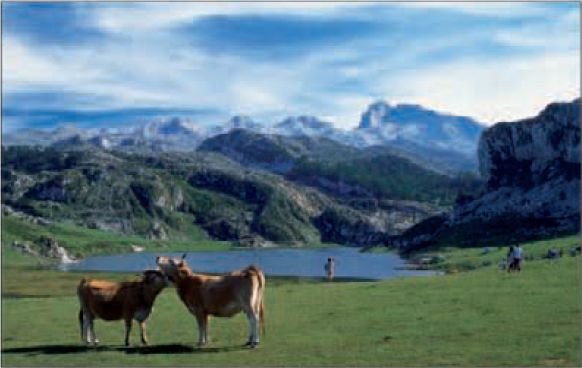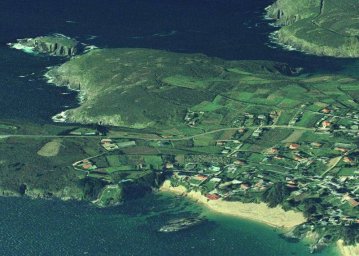Cantabria and Asturias
Picos de Europa mountains
Enigmatic cave art
Ancient churches of Oviedo
Medieval towns
These two regions form the central part of the green north coast. Both are composed of inland uplands descending to a gentle coastline punctuated by pretty bays and good beaches. The two regions share Spain’s most approachable mountain range, the Picos de Europa, whose canyons and summits are a draw for hikers. Prehistory and history are other regional fortes. The most famous of many caves painted by early humans are those of Altamira. The exquisite, pre-Romanesque churches of Oviedo and the town of Santillana del Mar, seemingly frozen in the Middle Ages, are also worth a visit.
Parque Nacional de los Picos de Europa, Cantabria

The Cave of Altamira
Lascaux Cave may be the most famous, but the discovery of the exceptional Cave of Altamira in 1879 — by an amateur archaeologist and his young daughter—led to the discovery of Paleolithic drawings, made with natural earth pigments and charcoal. Horses, deer, bison, and aurochs (an extinct species of wild cattle), as well as the outlines of human hands, adorn the walls of the cave. Early analyses date this prehistoric art to about 18,000 years ago, but recent studies suggest they were actually created about 35,600 years ago, at a time when humans were beginning to spread across northern Europe.
The prehistoric paintings that adorn the walls of the Cave of Altamira in Spain were discovered in 1879 by an amateur archaeologist and his young daughter. The Paleolithic drawings, which were made with charcoal and natural earth pigments, depict bison, aurochs (an extinct species of wild cattle), horses, deer and the outlines of human hands.
Scientists believe that most of the drawings were created between 14,000 and 18,500 years ago, though a recent study suggests that some of the artwork at Altamira was created about 35,600 years ago — at a time when humans were just starting to inhabit northern Europe.
A painted bison on the ceiling of Altamira cave in Spain. The cave is closed to the public because human incursions have caused damage to the 14,000-year-old paintings
Municipal Cemetery of La Carriona
Considered one of the most impressive cemeteries in Spain, it was created at the end of the 19th century in the suburb of Avilés, in Asturias. Its historical and artistic importance is mainly due to the artist Ricardo Marcos Bausa.
The Municipal Cemetery of La Carriona is a space created at the end of the 19th century as a funeral area on the outskirts of Avilés, Asturias. Its architect was Ricardo Marcos Bausá. It has great historical-artistic relevance and is therefore part of the ASCE (Association of Significant Cemeteries in Europe), in addition to leading the EUCEMET project, whose acronym in English stands for «European Cemeteries: Gardens of Souls, Diversity and Heritage», which has Its objective is to give importance to cemeteries through their musealization and enhancement.Historical contextIn Avilés at the end of the 19th century, the town experienced a stage of intense development, linked to port activity and trade with America, activities that generated a time of prosperity and a social class, the «Indianos». Industrial projects arise such as the Royal Asturian Mining Company. Urban expansion transcends the old limits of the walled city, from 1850 to 1920 it forms part of the current urban layout: the estuary is channeled, the new port of San Juan de Nieva is built, Sabugo and the Villa join with the commissioning of the food market and the first citizen expansion extends between the streets of Rivero and Llano Ponte. Also at this time, characteristic buildings of Avilés were built, such as the Armando Palacio Valdés theater and private residences such as those of Arias de la Noceda or Josefina Balsera. The first neighborhoods emerged on the outskirts to house the workers of the new factories such as Buenavista and La Magdalena. In addition to this, electricity and the telephone reach the town, and thanks to the incipient tourism linked above all to Salinas, an Electric Tram network is built to connect both towns.
Cementerio Municipal de La Carriona
El cementerio Municipal de La Carriona es un espacio creado a finales del siglo XIX como zona funeraria a las afueras de Avilés, Asturias. Su arquitecto fue Ricardo Marcos Bausá. Tiene gran relevancia histórico-artística y por ello forma parte de la ASCE (Association of Significant Cementeries in Europe), además de liderar el proyecto EUCEMET, cuyas siglas en inglés significan «Cementerios europeos: jardines de almas, diversidad y patrimonio», que tiene como objetivo dar importancia a los cementerios a través de su musealización y puesta en valor.Contexto históricoEn Avilés a finales del siglo XIX, la villa vive una etapa de intenso desarrollo, vinculado a la actividad portuaria y al comercio con América, actividades que generan una época de prosperidad y una clase social, los “indianos”. Surgen proyectos industriales como La Real Compañía Asturiana de Minas. La expansión urbana traspasa los viejos límites de la ciudad amurallada, a partir de 1850 y hasta 1920 va formándose parte del actual trazado urbano: se encauza la ría, se construye el nuevo puerto de San Juan de Nieva, Sabugo y la Villa se unen con la puesta en servicio del mercado de abastos y un primer ensanche ciudadano se extiende entre las calles de Rivero y Llano Ponte. También en este momento se construyen edificios característicos de Avilés como el teatro Armando Palacio Valdés y residencias particulares como las de Arias de la Noceda o Josefina Balsera. Surgen en la periferia los primeros barrios para alojar a los trabajadores de las nuevas fábricas como Buenavista y La Magdalena. Además de esto, llega la luz eléctrica y el teléfono a la villa, y gracias al incipiente turismo vinculado sobre todo a Salinas se construye una red de Tranvía Eléctrico, para comunicar ambas poblaciones.

